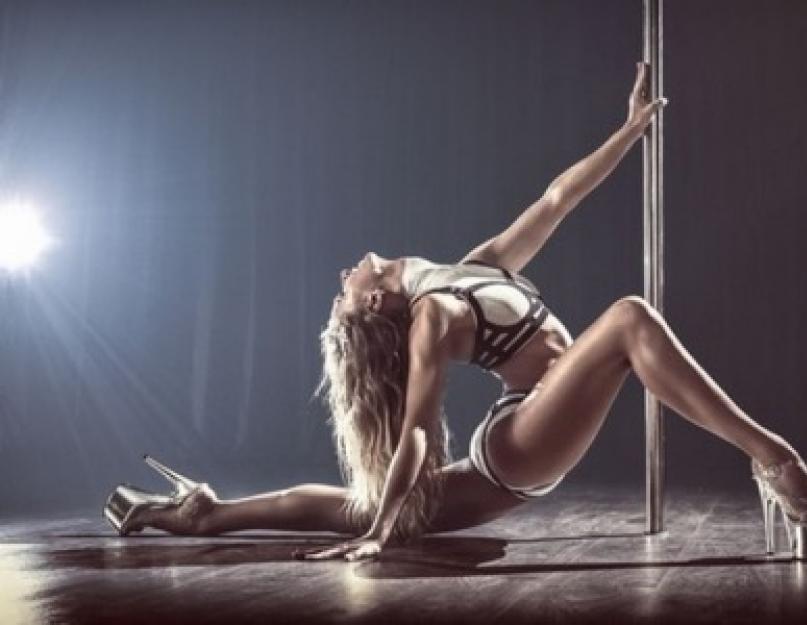In the classical sense pole dance It's part of the striptease. Striptease, in turn, is a well-known dance consisting of erotic movements of the hips, swings of loose hair, etc. However, having migrated from strip to fitness clubs, striptease began to be called strip plastic, and the elements performed on the , received their own development, and a new direction in fitness appeared - pole dance. Do not confuse pole dance with the usual striptease or strip plastic. Because it is a demanding sport. Can you imagine a gymnast on the bar? It's about the same with the pylon, only in a vertical position.
Of course there are different levels the professionalism of the dancers. If there is no desire to achieve some serious results, then it is quite possible to get by with strip plastic + simple elements with a pole. Simple elements are the most basic, elementary twists (an element performed on a pylon is called a twist). For example - you hold on to the pole with your hands and cling to it with your foot under the knee. It is worth saying that there are rotating and static pylons. Rotating are usually used, however, in good schools and fitness centers have both.
Elementary twists are needed in order to get used to the pole, master it, learn how to hold your weight with your hands. This will take you 2-4 lessons, depending on your physical fitness. Then the more difficult work begins. You have to learn twists at the top of the pylon (and for this you will need to learn how to climb it), twists with twines and even twists akin to acrobatic exercises. An experienced dancer, for example, can hold her body with one hand parallel to the pole, being upside down, and even depicting a beautiful split in the air.
If you have a burning desire to experience this activity for yourself, then I will try to give you some recommendations.
Firstly- it will be hard. You don't even know how much. At the first lesson, you definitely won’t get anything sensible, so don’t even think about getting upset. It starts to turn out usually only from the third time.
Secondly You will be told to bring high-heeled shoes to class. But do not rush to put on your working "boats" or old sandals that are "not a pity." In fact, shoes are not required in class. And from ordinary shoes you will get very tired. Do you know the feeling when you've been running all day in heels? And even more so if they are below average ...
For this kind of dance, only professional shoes are suitable, the so-called strips - shoes or boots with a platform and huge heels. The height of the platform is 1.5 cm, 4.5-5 cm, 6.5 cm, 8.5-9.5 cm, as well as very extreme, "freak" shoes, used only by dancers in strip clubs. Such shoes do not give a strong load on the ankle, which means that the legs in them get tired much less than in ordinary ones. And do not be afraid of high heels, when you try them on, you yourself will understand that they are very comfortable. You can buy them in specialized stores, if any, in your city, or in an online store of clothes and shoes for the show. Such stores carry out trade through postage and cash on delivery. The parcel will go about 2 weeks. The cost of such shoes in online stores is from 2500-3000 thousand.
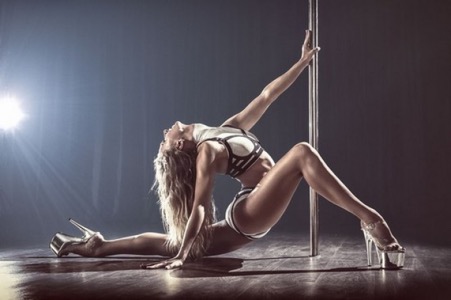 Professional shoes on the platform are also convenient because, when performing twists, you will have to push off the floor as much as possible, and they greatly increase the push force and, therefore, improve the quality of the twist. Basically, I would recommend buying them. Well, at least in order to feel how it is - for real. Sandals with a platform of 1.5-4.5 cm are suitable for classes. If it doesn’t matter to you, then just do it barefoot. This is much more convenient than amateurish options.
Professional shoes on the platform are also convenient because, when performing twists, you will have to push off the floor as much as possible, and they greatly increase the push force and, therefore, improve the quality of the twist. Basically, I would recommend buying them. Well, at least in order to feel how it is - for real. Sandals with a platform of 1.5-4.5 cm are suitable for classes. If it doesn’t matter to you, then just do it barefoot. This is much more convenient than amateurish options.
Thirdly- in the classroom, you absolutely must have your legs and arms bare to the shoulders. Best Option These are short shorts and a top. The fact is that in order to perform twists, friction between the metal pole and the skin is necessary. The fabric will just slide, and nothing will come of you. Now some companies produce special clothes for pole dance from non-slip fabrics. If, again, this is important to you, you can search the Internet.
Fourth, very important point- injuries. Injury number one, from which nothing will ever save you - BRUISES. For the first couple of weeks, your legs will simply be covered with huge black bruises. However, over time, the skin gets used, and the bruising disappears. Special creams will help speed up the healing process.
Next - dislocations and sprains. It goes without saying that stretching is important in pole dance. Warm-up and stretching exercises should be carried out at the beginning of each session. If you are not a gymnast and twine for you is something from the category of fantasy, do not be zealous. Otherwise, you can easily pull a nerve, pull or even tear a muscle and lose working capacity for for a long time. In addition, you can knock out a joint or dislocate your arm. The last injury, by the way, is very common. The advice here is the same - do not be zealous if you feel sorry for yourself. I was not very sorry, so I experienced, perhaps, all of the above. I don’t even mention the fact that you can easily twist your leg in high heels.
One more nuance- calluses on the palms. They can be quite impressive. Many suffer, and the coach, as a rule, always trains with bare hands. However, I advise you to buy ordinary leather car gloves. They will protect your hands from calluses, keep you strong and in general - it is much easier and more convenient to practice in them.
A couple more tricks- before training, you can not smear the body with creams or oils, and do not open the windows or turn on the air conditioner during the workout, as the cold pole becomes very slippery.
Here, in general, and all. It remains to add a few words about what coaches are. And pole dance coaches are former professional dancers or athletes who became interested in pole dancing, strip club dancers who earn extra money in schools, those who themselves once started as a student and eventually got involved. The best thing, of course, is to learn from professionals. Because they can teach you even the most difficult twists, properly warm up and give you the right load.
When choosing a place for training, be guided not by the prestige of the hall, but by the professionalism of the coach. Although this recommendation is more likely for those who have already been involved in any kind of dance or a proper sport before, for those who need serious exercise. For ladies, who are less experienced in this matter, everything is much simpler with the choice of a coach. You can go to any dancer who will help you master the basics of pole dance.
When going to a workout, do not forget to take a bottle of water, leather gloves, a warming cream for sprains and bruises, a cream for tired legs, a hair clip and a good mood.
Even despite the rapid development of Pole Dance (Paul Dance), many still do not know how pole dancing is called correctly. So, Pole Dance is a dance direction that has nothing to do with striptease. This is a pole dance (acrobatics on a pole), where the performance takes place on a static or rotating pole, at the same time combining:
- choreography;
- sports gymnastics;
- acrobatics.
Over the past decades, the direction of Pole Dance has become widespread throughout the world due to its diversity and versatility. Perhaps this is exactly the kind of sport in which there is always something to strive for and there is no limit to perfection. In it, it is impossible to immediately perform all the elements equally well, due to the physiological characteristics of the body. Gradually gaining strength, flexibility and endurance, the athlete replenishes the stock of mastered exercises, increases the level of their complexity.
The main directions of Pole Dance
Among the dancers of the whole world, there are three main Field directions Dance for which competitions are held:
Pole Art
![]() The emphasis of competitions in this direction is on the artistry and choreography of the dancer. Each performance should have a well-thought-out image, a story, which are accompanied by appropriate musical, sometimes visual, accompaniment. The flight of fantasy of the competitors is absolutely unlimited, there are no strict requirements and limits. The main task is the artistry, entertainment and scale of the performance. The most popular dance competitions in the world are: Pole Art France, Pole Art Cyprus, Pole Art Italy.
The emphasis of competitions in this direction is on the artistry and choreography of the dancer. Each performance should have a well-thought-out image, a story, which are accompanied by appropriate musical, sometimes visual, accompaniment. The flight of fantasy of the competitors is absolutely unlimited, there are no strict requirements and limits. The main task is the artistry, entertainment and scale of the performance. The most popular dance competitions in the world are: Pole Art France, Pole Art Cyprus, Pole Art Italy.
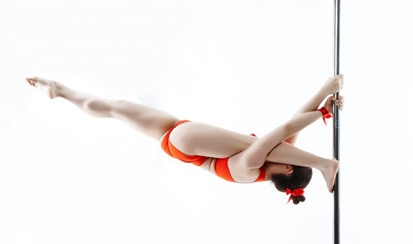
It is a discipline of air-strength athletics and has become an independent sports direction. Competitions are arranged international organizations and federations, which can only be judged by accredited judges. Strict requirements are put forward for athletes, costumes and music; failure to comply with them threatens with deduction of points or disqualification. The performance itself necessarily consists of a set of gymnastic and acrobatic exercises, each of which is worth a certain number of points. Technical performance guarantees the athlete a high total score. IPSF - international pole sport federation, or international federation pylon sports, is the main organizer of this type of competition.
 The peculiarity of this direction lies in the minimum set of power elements. The main attention is paid to the parterre choreography, plasticity and eroticism of the performance. Dancers compete in special shoes - strips. Don't be fooled into thinking that Pole Exotic is an easy destination. It requires not only strength and endurance, but also plasticity, the ability to work with the public, to fascinate and intrigue it. This is a triumph of femininity and dance, which is not subject to every dancer.
The peculiarity of this direction lies in the minimum set of power elements. The main attention is paid to the parterre choreography, plasticity and eroticism of the performance. Dancers compete in special shoes - strips. Don't be fooled into thinking that Pole Exotic is an easy destination. It requires not only strength and endurance, but also plasticity, the ability to work with the public, to fascinate and intrigue it. This is a triumph of femininity and dance, which is not subject to every dancer.
Now, thinking about what pole dancing is called, you can remember not only common name, but also a separate area of sport, understanding the subtleties and difference of the name.
Pole dance as fitness
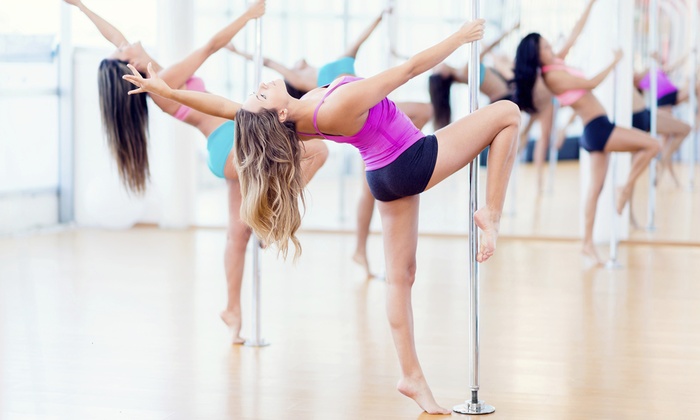 The high popularity of Pole dance is due to its versatility. During classes on the pole, the load is evenly distributed to all muscle groups, their elasticity and endurance increase. Bodyweight work promotes the development of the upper muscles, back, abs and legs without overloading a particular muscle group. Thus, the whole body is kept in good shape. The result is noticeable after the first month of classes.
The high popularity of Pole dance is due to its versatility. During classes on the pole, the load is evenly distributed to all muscle groups, their elasticity and endurance increase. Bodyweight work promotes the development of the upper muscles, back, abs and legs without overloading a particular muscle group. Thus, the whole body is kept in good shape. The result is noticeable after the first month of classes.
It should be noted that after the first lessons on the pole, the students have bruises, small bruises on the body. This is due to the fact that the skin is unusual for her pressure and force. After about a month, the elasticity of the skin increases, and the number of bruises is noticeably reduced. Seeming lightness is achieved through regular and diligent training, but those who have embarked on the path of Pole Dance will never turn away from it.
Equipment for Pole Dance
Pylon - direct equipment is a polished metal pipe, the diameter of which varies from 38 to 55 millimeters. The material of manufacture is stainless steel, sometimes a special coating is used: 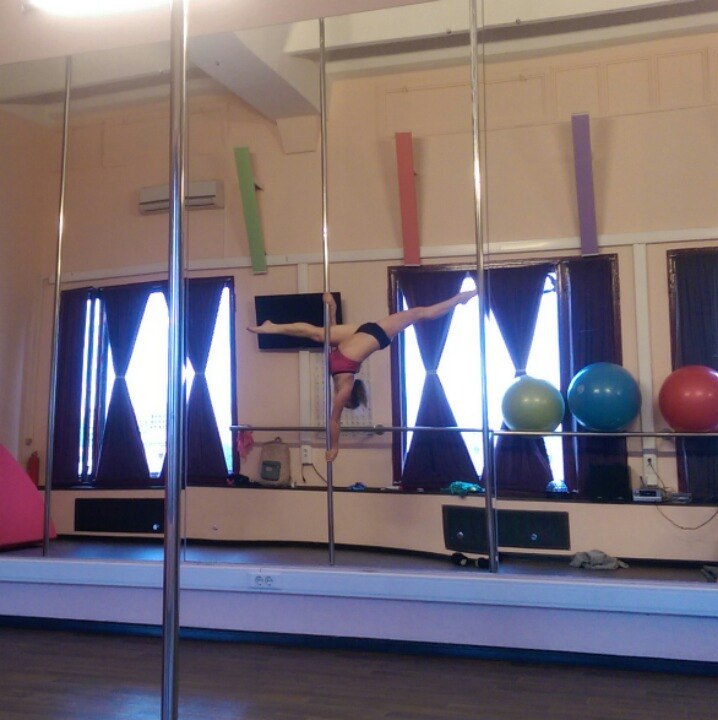
- chromium;
- titanium;
- brass;
- plastic;
- rubber.
This coating provides reliable grip and smooth gliding at the same time. The rubberized surface is used on Chinese pylons, which are becoming increasingly popular in recent times. It is recommended to engage in them in clothes, as sliding on such a pylon can cause burns. Pylons are installed and fixed depending on the characteristics of the room. These can be special stretch marks, frames for fastening or platforms. Anyway, prerequisite is the stability and reliability of fastening. Especially popular today are Chinese pylons, fixed only from above, thanks to which the athlete works not only in vertical or horizontal planes, but also diagonally.
Pole-dance or pole dance is one of the fitness areas that combines dance movements, plasticity and acrobatics. In our country, this direction appeared relatively recently, but has already become very popular. Today, half-dance is taught in almost any. And this is not surprising, because this direction of fitness is not only interesting, but also develops plasticity, improves coordination and stretching, increases self-esteem, and gives a good load on the muscles. The dance is performed on a hollow pole (pylon), whose diameter is about 5 cm. The pole is made of a “slippery” material - polished steel, which ensures smooth and fast movements of the dancer. At the same time, the pole rotates around its axis, which makes it possible to achieve greater entertainment. By signing up for a pole dance, you can forever forget about visiting the gym and doing boring exercises, pole dance will give you the necessary load and let you know what your body is capable of.
Some still consider striptease, but this is fundamentally not true. Pole dancing does not involve undressing. This is an independent performance with elements of acrobatics and choreography, revealing endless possibilities human bodies. In addition, half-dance has recently received the status of a sport.
If you want to practice pole dancing, then be patient. You will need it to achieve results despite the difficulties, calluses and bruises. If you want to take this sport seriously, and not just learn a couple of elements for a change, then in addition to patience, you will need flexibility, strength and endurance.
An important condition for classes are bare legs, arms and stomach. At the same time, your clothes should not be too revealing, as it will not be very comfortable to practice in it. The chest should be closed completely. The best form to wear is a non-slip top and short shorts. It is not superfluous to purchase special fingerless dance gloves: at first, this will help you avoid or minimize the appearance of calluses on your hands. Another important element of the floor dancer's equipment are high heels. Ordinary shoes will not work, at least for those who decide to do half-dance professionally. It is best to purchase special shoes, it not only securely fixes the ankle during the dance, but also the sole of such shoes is firmly in contact with the surface. However, at first you can practice barefoot.
As in any other sport, each session begins with a warm-up: stretching, warming up the joints and muscles. This is followed by the main part of the training, when all dance movements are practiced on the pylon. Beginners are given the basics of half-dance: they are taught to feel the pole correctly, to control the weight of their own body, while avoiding sprains and injuries. After the practitioner has confidence in the movements, training begins on the first twists at the top of the pole. Of course, to perform such numbers, good physical preparation is necessary, but do not be upset. With the proper level of patience and diligence, you will quickly achieve the desired result.
When going to class, do not forget to bring a bottle of water, cream for tired legs, a warming cream for bruises and sprains, a hair clip or hair tie and, of course, clothes for training. Do not forget that before training you can not lubricate the body with creams or oils. Otherwise, it is fraught with the fact that you will slide off the pole, you will not be able to perform the exercises, and in the worst case, you will get injured. Various special powders, liquid magnesia, or in the form of a powder, hairspray help to improve adhesion to the pylon. Also wipe the pole with alcohol as often as possible.
Please note that pole dancing is not recommended for people with increased blood pressure or disturbances in the functioning of the vestibular apparatus: twisting around a pole and hanging upside down require relatively healthy body. Those who suffer from problems with the heart or joints should also consult with their doctor and trainer.
Pole-dance is a pole dance with elements of acrobatics, or even pole acrobatics with dance elements. The forerunner of half-dance can be considered indian look sports - malkhamb. This sport originated in India in the 12th century among wrestlers as an exercise to develop agility, coordination and flexibility. They were mostly run by men. At that time, a teak pole was used as a projectile, approximately 2.5 meters high, 55 cm in diameter at the base, and 35 cm at the top. In the 15th century, the Malkhamb became traditional view sport in India, and is practiced in it to this day. However, a direct connection between half-dance and malkhamb has not been established.
Pole dance originated in its usual form in the 80s of the XX century in Canada in the form of an erotic pole dance. In the same form, he moved to the United States, then migrated to Europe, Asia and reached Australia itself. The environment for the performance of this dance formed an opinion about it as an erotic dance with striptease elements. But, like any other dance, pole dance has a strong expressive ability. People began to express themselves in different ways within this dance direction, which led to the formation of several styles of half-dance. Some of these directions are maximally isolated from the erotic component, although the form of clothing implies greater emancipation compared to other dance styles.
Directions in pole dance
Thus, several directions of half-dance were formed. All these directions to one degree or another can be attributed to two categories - artistic and sports. (artist and fitness). Although, in some areas, the artistic and sports components must be in harmony, which makes it difficult to identify these areas on a dual basis.
- Erotic pole dance. Historically, the first direction is a pole dance with striptease elements.
- Paul Art. Then such a direction as Pole Art was formed, where the choreography, appearance dancer and acrobatic techniques are in balance and make up the body of the artistic number
- Exotic half-dance. The direction of exotic pole dance Exotic Pole-Dance has also been formed, in which the emphasis is primarily on the dancer's choreographic capabilities, and elements of acrobatics are present to a lesser extent.
- Sports half-dance. Now even children and their parents can afford to dance on a pole, because. Pole-Dance came to its origins as a sports direction as Sport Pole-Dance, in which competitions are held.
- Fitness half-dance. A more liberal form of Sport Pole-Dance was Fitness Pole-Dance. With the development of the fitness industry, pole dancing has become fashionable in a wealthy society. Fitness Paul Dance classes are held in free form, so everyone can find something interesting for themselves in this kind of fitness and dance. It is actively promoted in various age groups, from children to overweight people.
Returning to the question of what half-dance is - a sport or a dance, it is difficult to draw specific conclusions. It all depends on your preferences. Everyone can realize themselves in this direction as their heart desires. For some it is a way of life, for others it is a way of self-expression, for others it is beauty and health.
Basic Pole Dance Techniques
Thus, half-dance combines acrobatic and dance techniques.
- The pole dancer, or dancer, must first learn some simple tricks to get used to the pole. These are twists and rotations without leaving the floor, or in a low jump.
- Various contracts and splits are often used. Twine can be performed with twisting.
- The third component of the technique is grips. Grips are made with legs, arms, knees, hips, arms and back, arms and side, and generally with any part of the body, as far as possible.
- To perform techniques in the upper and middle part of the pylon, you need to learn how to not only hold on to it, but also climb it up and down.
- Therefore, you also need to learn how to effectively descend from the pylon down.
Acrobatic and dance elements are performed in one of three positions.
- At the bottom of the pylon, suspended, standing or lying on the floor.
- In the middle part of the pylon - above 1.5 meters from the floor.
- And in the upper part of the pylon, Above 2 meters from the ground.
Choreographic component of half-dance
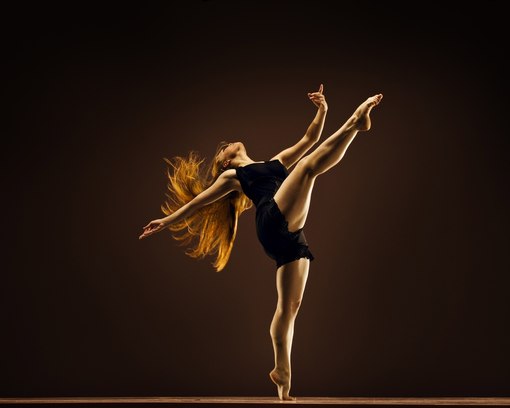
The dancer, or pole dancer, combines these elements in one dance composition. Some elements in the lower part of the pylon are borrowed from other dance styles, sometimes even classical ballet, to give the dance a more aesthetic and sublime quality.
Sometimes dance numbers are presented with the participation of two or more dancers. In this case, various supports from sports dances and acrobatics are sometimes used as well. But in most cases, the dancers are each located at their own pylon and perform the elements of the dance synchronously, or in some kind of harmonious sequence.
The sports component of half-dance
When visiting a fitness club where they do fitness half-dance, you will probably be told about how well it affects health. Half-dance of this direction provides aerobic and physical activity on the whole body, during the exercises, stretching is trained, coordination of movements improves, muscles and joints are strengthened, attractive body contours are formed. And at the same time - it's erotic, practical and beautiful. Isolating the erotic component, and focusing on physical development, you can make half-dance accessible to children and to the widest segments of the population. And so, what are the basic requirements for those who want to practice half-dance?
The main projectile for practicing half-dance
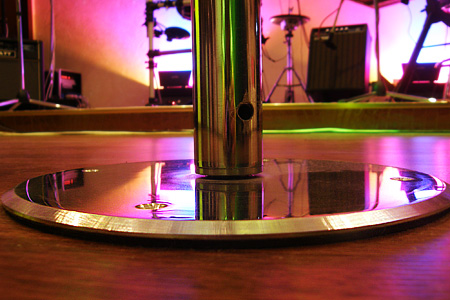
To practice half-dance, nothing is required - it's a special pylon or pole.
Pylons are fixed:
- expansion method,
- or at the bottom of the floor.
Pylons are classified according to the method of device, and there are:
- revolving,
- statically fixed,
- Or combined.
Depending on the chosen direction of half-dance, preference may be given to one or another type of pylons. From an aesthetic point of view, numbers performed on a rotating pylon look more spectacular when spinning. Such pylons are fixed with a spacer method, and are mounted on bearings with a stopper. In sports, however, sometimes static pylons are preferable, since grip is better with them. The most expensive pylons are equipped in such a way that you can use them both in a static or dynamic version, at your discretion.
Pylons are also made of various materials. There are pylons:
- from copper,
- stainless steel,
- Rubberized.
Rubberized pylons and copper pylons provide maximum grip. Copper pylons heat up too quickly and rub against the skin. Rubber pylons are also called Chinese pylons, they are not used in dances. But steel pylons have proven themselves best in the dance direction, and are quite applicable for acrobatic techniques on them.
Requirements for students when practicing half-dance
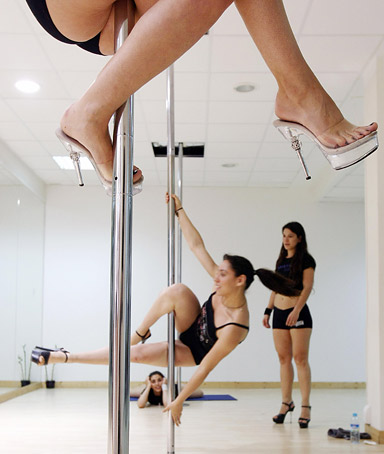
Half-dance can be practiced by both men and women. Some areas of po-dance are practically devoid of an erotic component. On the other hand, male dancers are also very popular in clubs, so that everyone can fulfill themselves to the best of their ability.
Fitness half-dance is a sport, and it can be practiced by both adults and children. Although there is still a prejudice in the minds of people towards pole dance, nevertheless, in last years, this stereotype is subjected to powerful criticism, and people have already realized the enormous benefits that pole lessons bring.
Health restrictions, however, are present. Since the grips on the pole are performed with open areas of the skin, the presence of skin diseases, dermatitis and serious skin damage is contraindicated when practicing this art. In case of serious violations of coordination, you should also not approach the pylon. If you seriously engage in half-dance, there are risks of joint injuries, muscle strains. So it is better to limit yourself from these activities if you are experiencing joint problems, or have any muscle problems. The same applies to the load on the heart, there is nothing to say.
However, in general, everyone can realize themselves at a convenient level. It is not necessary to show the wonders of acrobatics on a pole. And if the soul lies in this type of dance, then why not. The main thing is that it is not harmful to health.
Pole dance uniform
Dress code, in this context, plays great importance. Depending on what elements you are going to perform, you will need to undress to one degree or another. Since complex techniques are performed on a pole, it is necessary to ensure maximum grip of the pole with exposed skin.
Clothing. The optimal shape for half-dance for women is a top or shorts, but for complex grips, it is better to use a bikini. Such captures can be inside hips, and other parts of the body that the top can cover. Men in this regard should be somewhat easier.
On the other hand, now there is no need to dress so revealingly, because there are special non-slip clothes for practicing half-dance made of synthetic or natural materials. Such clothes can be found on the Internet, on special sites.
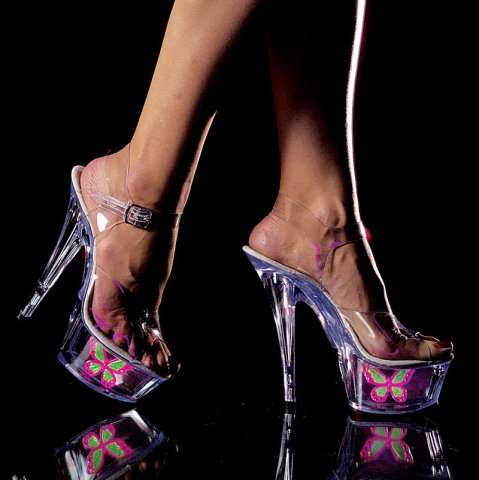
Shoes. Pole dancers often use special shoes in their numbers. This applies, first of all, to erotic dances, since such elements are prohibited at competitions. However, some numbers look very impressive when women perform dance elements in high platform shoes. However, not all high platform shoes are suitable for this.
Since ordinary shoes put too much stress on the feet and joints when dancing, you should use special shoes - strips. Strips come with platforms from 1.5 to 9.4 cm high. Also, sometimes ladies wear boots, or exotic shoes, which would play a significant role in the overall aesthetics of the room. Here you have to be careful with the choice. In general, the use of shoes in complex acrobatic numbers is contraindicated, so in most cases you can do without shoes at all.
Conditions of education
You should study half-dance under the guidance of experienced trainers who will be able to support you and correctly realize your potential. Only a good coach will help you discover your personal abilities and overcome barriers that are unique to you. To do this, the coach must have his own experience with the pole, as well as have some teaching experience.
Half-dance classes must be carried out in a room without drafts, it is clear why. You should also warn yourself against the use of various creams and lotions during classes, as they can slide on the surface of the pole. It is better to keep the average natural level of acidity of the skin, and if possible remove excess fat.
To keep the pylon from slipping, it should be cleaned regularly with an alcohol-based cleaner. You can also use magnesium. They say that you can also use hairspray, but I would not like to apply it on the skin, and if you apply it to the pole, it will not get better. Better apply special formulations for better grip in the form of powders (mighty grip) and ointments (Frim Grip, iTac).
Pole dance job
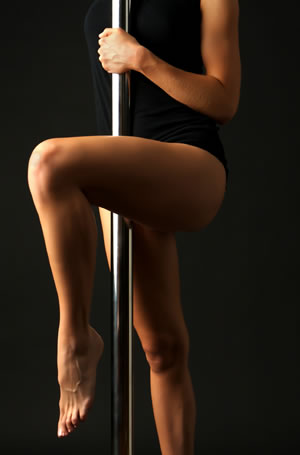
You can dance half-dance for your own pleasure, for physical development, or in public. Depending on the degree of your realization, you can demonstrate your abilities more or less openly.
Now on the Internet you can find more and more offers that pole-dance dancers are required to work in one place or another. Most often, this involves working in a nightclub or bar, where dancers attract the attention of customers, and thus provide a good income for the bar.
Bars and clubs get the maximum financial benefit when dancers not only lure customers with dances, but also engage in communication with them. Thus, the bar's revenue increases one and a half to two times, due to the cost of drinks that customers order for ladies. It should be understood, however, that such gestures are not always performed disinterestedly.
Therefore, you need to have a few incendiary numbers in stock, which will serve as a payment for the generosity of club visitors. You can imagine how high the level of skill of a dancer, or the gallantry of a gentleman, must be so that such communication does not turn into a conflict. Unfortunately, many clubs and agencies do not always take care of the ladies, as they would like, especially abroad. This is due to the legal norms in these states and ensuring safety and comfortable living in another country.
Our agency provides high-quality employment services for dancers in Russia and abroad. We have vacancies for dancerspoledance in clubs in Moscow, Lebanon, Turkey, Thailand, China and other countries. To work in our clubs, a work permit is issued, we provide organized accommodation and flights to the place of employment, we provide optimal conditions labor and compliance with the rules of the labor contract.
If you want to see the world, provide yourself with a decent income, or just start from scratch in a new country for you, you can try to contact our company. Sometimes we accept dancers even without work experience. If you are interested, study the offers on our website and fill out the applicant's questionnaire, honestly providing the necessary data about yourself.
Today, fitness clubs and gyms offer their customers big choice types of sports training. Quite popular recently was strip plastic, which was a combination of training and elements of erotic dance. This type of activity attracted a lot of attention, as it was considered indecent and defiant, but over time, many realized that this is a great way to maintain your figure, and at the same time enjoy a varied workout. But, later, a new trend arose, which is called half-dance (pole dance).
Half dance is one of the directions in sports, which combines erotic dances and acrobatic gymnastics performed on a pylon (metal pipe). Half-dance is a great way to work out all the muscles of the body at once.
Why do girls start pol-dance:
- The most important thing is that pole dance maintains a good condition of the body, that is, it significantly improves the muscles, your body becomes slim and fit.
- There is no precisely built training program, so you will not get tired of the same type of exercises and repetitions. All training will look like a dance, and this is much more fun and time passes unnoticed.
- It has been proven that those girls who do half-dance feel much more confident. This is due to the fact that such dances significantly attract male attention, a woman is aware of this subconsciously and this is reflected in her appearance.
- Half-dance is available for everyone to practice. It doesn't matter your age or gender.
Even though in Russia half dance appeared relatively recently, in world practice it has already managed to acquire several directions. Here are the main directions in pole dance:
- Field Art. Training in this direction focuses on ensuring that all acrobatics are performed on the very highest level. Also very important is the technique of execution and the corresponding manner of the speaker. That is, this dance is designed for public performance, as an art form.
- Exotic Pole Dance. Here, more attention is paid to the choreography and plasticity of the dancer. Acrobatics and precision technique fade into the background.
- Pole sport. As you can already understand from the name, the main emphasis is only on the quality of the displayed acrobatics. The technique and physical preparation of the participant is very important.
- Pole fitness. It is considered the most difficult direction of all of the above, as it combines all the complex acrobatic combinations. It requires considerable physical fitness, flexibility and endurance.
Video: "What is pole dance?"

